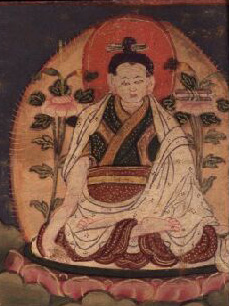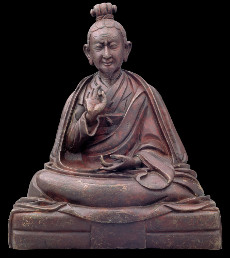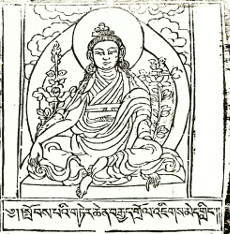
Jigme Lingpa

Jigme Lingpa
Jigme Lingpa was born in 1729 or 1730 in the Yarlung Valley of Tibet, not far from the dynastic tombs of Chonggye. At the age of six he was moved to the fifteenth century Nyingma monastery Pelri Osel Tekchenling in Chonggye. According to his autobiography, Jigme Lingpa went to the monastery with a group of monks from Kham after one of the monks died near his home. At Pelri, despite the inspiration that drew him from home at such an early age, he apparently had little interest in monastic pursuits and spent his time in idle play.
Things changed at the age of thirteen, when Jigme Lingpa began his training in earnest, studying with Ngawang Lobzang Pema, who gave him the name Pema Khyentse Ozer Nesarwa Ngawang Kunga Lepai Jungne (1704-1760) gave him his getsul vows. Neten Kunzang Ozer gave him teachings in Nyingma treasure cycles such as the Droltik Gongpa Rangdrol of Trengpo Drodul Lingpa (1517-1584) and key Nyingma scriptures such as the Lama Gongdu. He also studied Indian Buddhist classics with his relative, Zhanggom Dharmakirti.
At Pelri Jigme Lingpa also met the great master Tukchok Dorje and received several important transmissions from him, including Mahamudra and the Yeshe Tongdrol of Tennyi Lingpa (1480-1535). He went on to study with a number of other teachers such as Tendzin Yeshe Lhundrub (died 1795) and Tangdrokpon Pema Chokgrub, training in both Nyingma kama and terma as well as certain tantric cycles from the new translation traditions.
When he was twenty-eight, Jigme Lingpa entered a three-year retreat at Pelri, basing his practice on a number of popular treasury cycles such as the Droltik Gongpa Rangdrol of Drodul Lingpa. During this retreat he experienced numerous visions of deities, most famously one, on a winter night in 1757, in which he found himself at the great Jarung Kasho stupa in Boudhanath, Nepal. There a wisdom dakini bestowed on him the Longchen Nyingtik treasure cycle, a revelation later classified as "mind treasure. He is said to have kept the revelations secret for seven years, despite the urging of his associates.
In his autobiography Jigme Lingpa described the process of his vision of and of receiving the Longchen Nyingtik is remarkable detail. He relates how he opened the small box the dakini gave him, finding inside five scrolls of yellow paper. Overcome by the smell of camphor, his initial doubt over not being able to understand the letters cleared away when the writing suddenly became legible to him. Checking to be sure that the treasure was indeed meant for him, he memorized the first text, a sadhana concerning Avalokiteshvara and then the second, when first Rahula, the treasure protector arrived to congratulate him, and then the dakini again to chastize him for being too eager to broadcast the revelation. She demands that he eat the texts, which he does, swallowing them whole so as not to destroy them.

Jigme Lingpa
At the age of thirty-one Jigme Lingpa entered a second three-year retreat, this time at the Upper and Lower Nyang caves at Samye Chimpu. During this retreat he experienced three visions of Longchenpa Drime Ozer (1308-1364) in which he received that master's blessing of body, speech, and mind. According the tradition, in the visions Longchenpa encouraged Jigme Lingpa to disclose his visionary treasures and teach them to others. In one of the visions Longchenpa gave him a book, saying that it contained all the key instructions that he had not expanded in his Trilogy of the Natural Ease of Mind, thus giving Jigme Lingpa permission to compose his own masterpiece, the Yonten Dzod. In the third vision Jigme Lingpa's mind merged with Longchenpa's in the expanse of primordial purity, and Longchenpa confirmed that Jigme Lingpa was a master of absolute realization.
During his second retreat Jigme Lingpa wandered the Chimpu valley giving teachings to an increasing number of disciples and highly placed patrons. When he emerged from retreat in 1762, with the patronage of the Dabden Yungdrung Kyilwai Tsal family, he established a hermitage in Chonggye, Tseringjong where he ultimately began to transmit the Longchen Nyingtik. Now actively patronized by a number of prominent aristocratic families, his fame grew to extent of being occasionally conscripted to perform rituals on behalf of the Tibetan government in Lhasa.
Jigme Lingpa never fully ordained, living as a tantrika, with a topknot and robes. He may have had several consorts, including a woman from the Dabden Yungdrung clan, known as Yungdrung Kyilwa, and a nun named Tsang Gyangru Pelding Jetsunma. He never publicly acknowledged the patrimony of his only known son, Nyinche Ozer, who was born late in his life.
Jigme Lingpa had several close relationships with hierarchs of traditions other than the Nyingma. He taught and studied with Ngawang Kunga Lodro (1729-1783) the thirty-second Sakya Tridzin, who encouraged him to compose his scholarly works, chief among them the Yonten Dzod, a work belonging to the stages of the path genre which he wrote between 1779 and 1781. He was also close to the third Drigung Chungtsang, Chokyi Nyima (1755-1792), of whom his son, Nyinche Ozer was recognized as the reincarnation and enthroned at Drigung in 1797.
It was in the Nyingma tradition that Jigme Lingpa had his greatest influence. He aided in the restoration of Chuwori, a monastery outside of Lhasa established by Tangtong Gyelpo (1361-1485), befriending the head incarnation, the Sixth Chagsam Tulku Lobzang Chodan. Jigme Lingpa also worked to restore Nyingma temples, such as the imperial-era Zhwai Lhakang and Samye.
Most importantly, Jigme Lingpa had a number of disciples from Kham who went on to significantly impact their home region, although he himself never visited the region. Chief among these were Jigme Trinle Ozer, later known as the First Dodrubchen (1745-1821), and Jigme Gyelwai Nyugu (1765-1842). He also trained several leading lamas of Dzogchen and Katok, including the sixth abbot of Dzogchen, Namkha Tsewang Chokdrub (b. 1744), and Getse Pandita Gyurme Tsewang Chokdrub of Katok (1761-1829), who edited his collected works.

Jigme Lingpa
Perhaps of equal importance to his training of Nyingma lamas from Kham and the subsequent spread there of the Longchen Nyingtik teachings was his involvement with the royal family of Dege. The Dege king Sawang Kungrub Dega Zangpo (1768-1790) and his wife Tsewang Lhamo visited Jigme Lingpa in 1788, meeting him for the first time.
At the time Jigme Lingpa was in retreat at Tsering Jong, and when he heard that they royal family with their large entourage was coming, he sent word to meet him at Samye so as to spare his small hermitage community the burden of such a large group. Jigme Lingpa developed a close relationship with the queen, whom he described as "very intelligent, with good propensities," despite rushing through the teachings he gave her and urging them to leave quickly, so as to lesson the impact of their royal demands on the local people.
When her husband died two years later, Tsewang Lhamo assumed control of Dege on behalf of her infant son, elevating Jigme Lingpa's disciple, Jigme Trinle Ozer, to a prominent status; scholars have speculated that this was perceived as a significant threat to the court's traditionally Sakya religious leadership and that following Jigme Lingpa's death a wave of anti-Nyingma violence swept Dege. There is no evidence that such a thing happened, and both Tsewang Lhamo and the First Dodrubchen continued to be active in Dege politics and religion for well over a decade.
It was under the queen's sponsorship, between 1794 and 1798, that Jigme Lingpa oversaw the printing of his edition of the Nyingma Gyubum, a compilation of all Nyingma tantra, in twenty-eight volumes. He had begun gathering and copying texts for the collection back in 1771, soon after leaving his second three-year retreat. He based it on Ratna Lingpa's (1403-1479) edition, no longer extant, in forty-two volumes.
Jigme Lingpa passed away in 1798, at the age of sixty-nine, at his seat at Tsering Jong.
Biography of Jigme Lingpa courtesy of www.treasuryoflives.org.